Perched on Thailand’s border with Myanmar, Arunothai is a dusty crossroads town, a nowheresville that could be the setting of some Southeast Asian spaghetti Western. Its main street is the final, dead-end section of the two-lane highway from Chiang Mai, Thailand’s second largest city 120kms south, and the heart of the kingdom’s mountainous north.
At the town boundary, a Chinese-style arch capped with dragons also bears Thai script declaring fealty to Bangkok’s royal family: “Long live the King!” Further on, Chinese lanterns line the main street, and on the hillsides, courtyard homes sit among warrens of narrow, winding alleyways and behind cinderblock walls topped with broken glass and protruding nails. Local administrators cannot say precisely how many people live in Arunothai, but calculating from the total daily consumption of eggs — at one per person per day — they estimate the population to be around 20,000.
CHINESE CIVIL WAR

Photo: David Frazier
As a mother tongue, most of Arunothai’s residents speak either Mandarin Chinese or Yunnanese, a dialect from China’s southwestern Yunnan province, which as the crow flies is only 200kms away, with several insurgent-controlled areas in Myanmar’s mountainous fringe lying between. Many in the village will proudly tell you their Yunnanese grandfathers and great-grandfathers once fought as part of Chiang Kai-shek’s (蔣介石) Chinese Nationalist Party (KMT) armies against Mao Zedong’s (毛澤東) communists in the Chinese Civil War.
Following the KMT’s defeat in 1949, and Chaing Kai-shek taking the KMT to form a government in Taiwan, the regional groups left behind existed for decades as rogue militias in the borderlands of Burma, Thailand and Laos, where they for a time transformed into the first major opium warlords of the Golden Triangle.
Eventually, they became known to history as the KMT’s Lost Army and settled 108 villages throughout northern Thailand, where their descendants, now estimated to be around 200,000 in number, still live today.
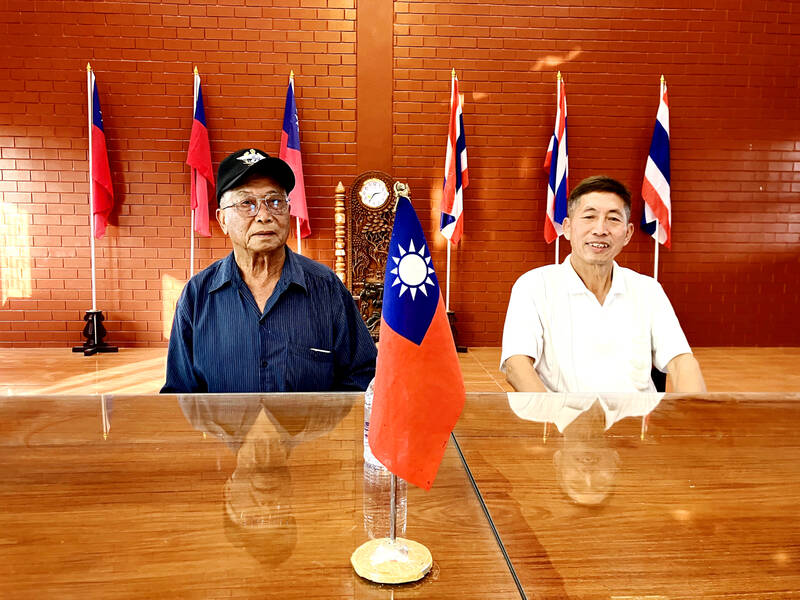
Photo: David Frazier
For most of their history, these villages — known as “Yunnan villages” in Thai and Chinese but as “KMT villages” in much English-language reporting — looked to Taiwan for the source of their Chinese identity. But that is now changing.
“Arunothai is split in two sides,” says Aranya Siriphon, an assistant professor of sociology and anthropology at Chiang Mai University, who studies Chinese influence in northern Thailand. Speaking in an open-air coffee shop just outside Chiang Mai University’s sociology department, Siriphon said the divide is centered on the village schools, and their choice of aligning their education systems with China or Taiwan.
So far, 44 of Thailand’s more than 140 Yunnan village schools have switched from Taiwanese to Chinese educational systems and patronage, united under the umbrella of the Jiaolian Foundation.

Photo: David Frazier
“Ten years back, almost all the schools along the border used a Taiwan-based curriculum,” she says. “But since that time things have really changed.”
In Arunothai’s market, a collection of open-faced shops under weather-stained tarps and umbrellas, several villagers readily joke, “Yes, we have two high schools. One is Taiwanese, and the other is Chinese.”
One fruit seller, a woman surnamed Zhang, explains that she sent her children to the Huaxing School (華興中學), aligned with Taiwan since it was founded in 1971, simply because “it’s the village school,” the school that she herself attended, which has served the community for more than 50 years. For her, it was a default of civic participation.
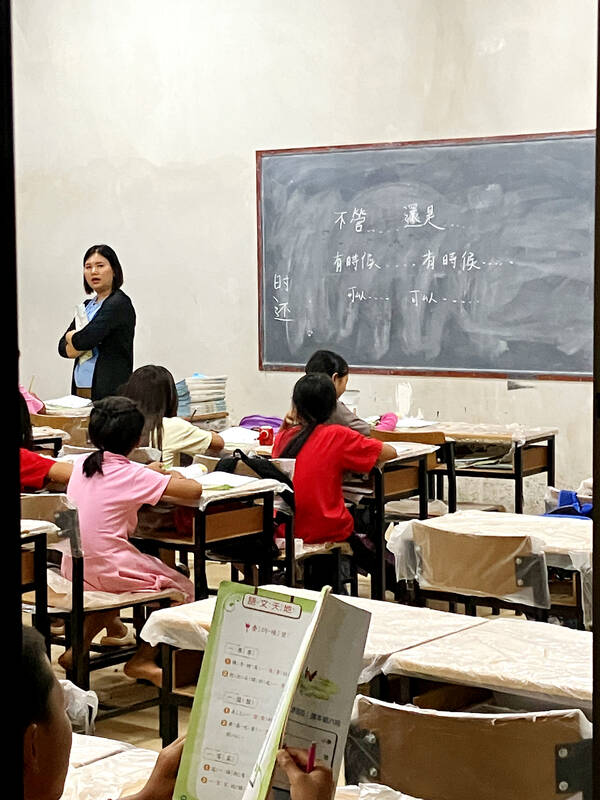
Photo: David Frazier
Ms Li, the feisty proprietress of a shop selling Chinese religious wares like lanterns and ghost money, however, declared she is hedging her bets, sending two of her three children to Huaxing, but one to the Jiaolian School (教聯高級中學), which is China-aligned.
“I want to see how the schools compare,” she said.
At the dry-goods shop just next door, Mr Chou, thirtyish, stout and cheerful, says he’d just returned from Taiwan a year earlier, where he’d worked as a cook frying up pad thai in a northern Taiwan industrial suburb in Taoyuan County. His salary at that job was roughly NT$27,000 per month, more then double what he can earn in Arunothai, but “there, I was a wailao,” he said, using the Mandarin term for “migrant laborer.” For that pay, how could I ever live there? How could I buy a house? But this is our home,” Chou continues, pointing to a two-story, Lanna-style wooden building across the street. “We can own this. We can own houses here.”
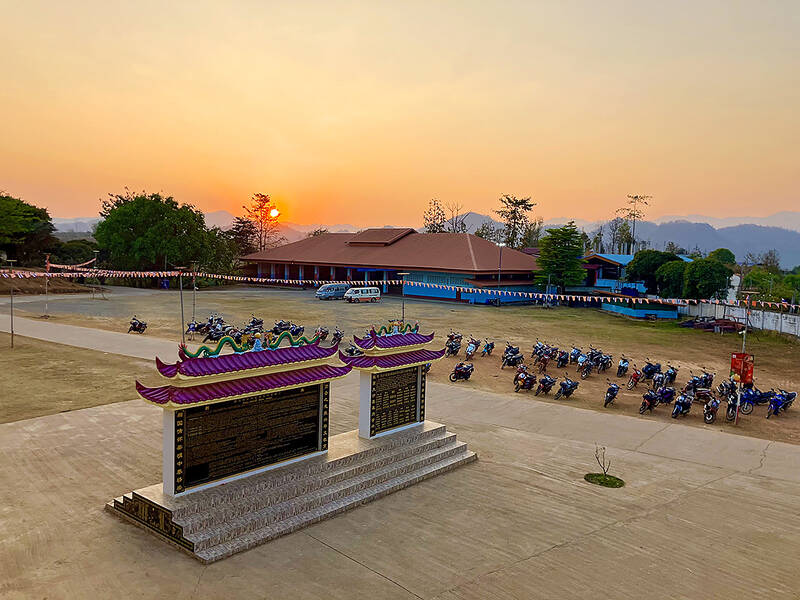
Photo: David Frazier
THE WATERSHED
The soft-power competition that has now embroiled Thailand’s Chinese Nationalist diaspora began around 20 years ago, a moment when Taiwan’s government policy took an inwards turn and China began an unprecedented expansion. In Taiwan, the turning point was the 2000 election of a new government led by the Taiwan-centric Democratic Progressive Party (DPP), which has held Taiwan’s presidency for 17 of the last 25 years, marking a shift in the nation’s politics away from Chinese identity towards Taiwanese, including a deprioritization of external legacy commitments, like the Yunnan villages.
These days, China offers the Yunnan villages greater cash assistance, a chance to reconnect with their ancestral homes, and relatively open-ended college education, though it also demands strict adherence to the communist party’s revisionist historical narratives and political goals, like the incorporation of Taiwan into the PRC, a move many in Taiwan see as “annexation” and an end to their democratic freedoms.

Photo: David Frazier
Taiwan, meanwhile, offers the villages more modern education using traditional Chinese characters, rather than the simplified script used in China. While Taiwan’s financial assistance has few political strings attached, its study programs often railroad village students into programs that have them splitting time between universities and jobs in grocery stores or factories. It’s a devil’s choice, and one that has villagers rethinking both identity and allegiances. As parents decide which school to send their children to, they also weigh a past that links them to Taiwan against a future that may lead them to China.
The watershed moment for Arunothai’s villagers came in 2004. That year, a Taiwanese government budget providing assistance to all Thailand’s diaspora communities expired, and the new DPP government initially did not renew it. The result was the first pause of aid in more than half a century.
Arunothai was then home to the largest Chinese diaspora school in southeast Asia, the Huaxing School, with about 1,000 students. As in each of Thailand’s KMT villages, the school was the community’s beating heart, the main civic institution for transmitting Chinese language, culture and identity to the next generation.
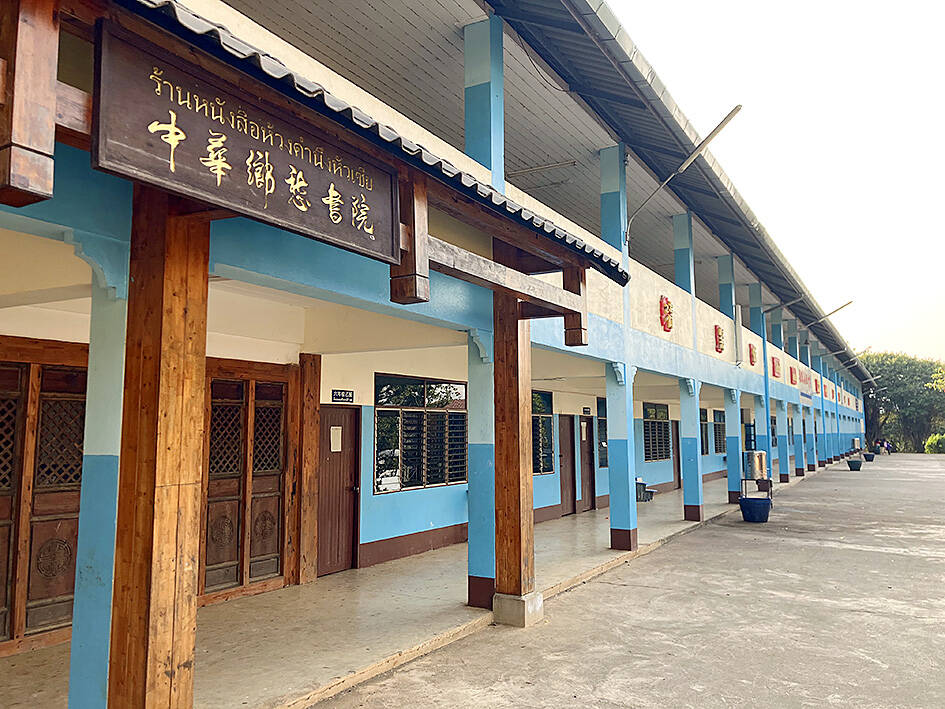
Photo: David Frazier
Though the school had relied on aid from Taiwan since its founding in 1971, Huaxing principal Wang Hsiang-sian (王相賢) was suddenly forced to wonder not only where he would get textbooks for the coming year, but also whether Taiwan, after decades of providing a steady flow of teaching materials, scholarships and teacher training programs — in addition to infrastructure support for the construction of roads, bridges, school buildings and water sources throughout northern Thailand — was finally turning off the tap.
Wang was not ignorant of the sea change in Taiwanese politics that led to the stalled budget. Sensing a full-fledged crisis, he assembled a group of regional school heads and pushed a course of action that had previously been unthinkable. He went to China’s Consulate General in Chiang Mai to ask for help.
ODD REQUEST
China’s diplomatic officials initially didn’t know what to make of a request from this unexpected delegation, whom they’d assumed to be die-hard KMT loyalists. But two years later in 2006, consul-general Peng Rendong (彭仁東) visited the Huaxing School in its remote, red-dirt valley and brought with him twelve boxes of textbooks and 250,000 Thai Baht (NT$227,500) in scholarships.
When Peng arrived, he was greeted by almost 1,000 students lining the road for almost half a kilometer and waving the five-star red flag of the People’s Republic of China. In his welcome speech, Wang declared, “the hearts of Chinese on both sides of the Taiwan Strait and the vast majority of overseas Chinese have long been united.”
Arunothai’s village elders were outraged.
“We thought, ‘How could he bring our ancestors’ enemy into our village?’” says 86-year-old Lee Hsiao-ho (李小和), Huaxing School’s current principal.
Drinking oolong tea with other school leaders on one of the school’s long verandas, Lee, a humble man with copper-colored skin and a thick Yunnan accent, recalled the imbroglio that followed the Chinese consul’s visit. Wang was forced to resign, and village elders moved quickly to reassure Taiwan’s government that the Huaxing School would continue its unwavering allegiance to Taiwan and its Republic of China government.
“We at Huaxing will never change our mentality,” says Kuang Ti-wei (匡體位), 61, a senior instructor at the school. “We have to be grateful to the Taiwan government for its care and help for us over the past 50 years. We will always hold this in our hearts.”
Principal Lee was even more adamant.
“Truly,” he says, “our school is inseparable from the government of the Republic of China (ROC) in Taiwan.”
But Wang, having secured the backing of China’s government, was not dissuaded. He saw that Chinese language education in southeast Asia’s diaspora communities was gradually switching from the traditional Chinese characters used in Taiwan and Hong Kong to the simplified characters used in China.
“He felt, ‘I cannot be satisfied, because I still feel that learning simplified Chinese characters is the correct path, and because China is getting stronger,’” said his daughter, Wang Mingming (王明明). “His thinking was more far-sighted than others.”
In 2011, on a hillside just 10 minutes’ drive by motor scooter from the Huaxing School, Wang Hsiang-sian established the rival, Jiaolian School, that would use China’s teaching system. About half the funding came from the Chinese Consulate in Chiang Mai and an agency of the PRC’s Ministry of Education known as the Hanban, or Center for Language Education and Cooperation.
Mingming, now 45 and the Jiaolian School principal, said that for the rest, her father used his own resources and raised funds from the Yunnan diaspora community. Ms Wang now also heads the umbrella Jiaolian Foundation.
“It didn’t matter if we didn’t have food on the table,” she said, “we absolutely knew we had to build this school,” she says.
NEW FACILITY
I met with Mingming in the Jiaolian School’s newest facility, a freshly painted three-story administration building, which also houses the school’s single-room computer center, where students cram into about 50 cubicles equipped with China-donated desktop computers.
As I sat down in her office on a well creased, cream-colored sofa, she gave me a flat look.
“See how economical we are? We bought this sofa 14 years ago. And those curtains, five years ago. In a year, maybe we can save about THB 50,000 [NT$45,437] in our budget for these kinds of things.”
Shrugging with her eyebrows, she added, “We do what we can.”
Wang is bespectacled, heavy-set and has the commanding air of a harried, hands-on administrator. As we spoke, her phone and computer screens continually exploded with text bubbles from LINE and WeChat messenger apps.
“One thing I am very proud of is that the Mandarin we speak here is very standard,” she said. “If you go to some of the small village schools you will not be able to understand them. They don’t speak Mandarin there. They speak Yunnanese.”
On a later tour of the school, my guide, a locally born 18-year-old teacher-in-training named Xiao Fan, spoke fluent Mandarin with the curling “er’s” of a Beijing accent. As we poked our heads into classrooms, Xiao Fan pointed out several teachers who’ve been sent to the school from China, including one prim woman from Guizhou. Before COVID-19, Chinese government programs were sending up to 2,000 teachers a year to Thailand at little or no cost to the host institutions
Just a dozen years since the Jiaolian School was founded, it now rivals the Huaxing School in size and resources. Both currently claim around 1,600 students and operate as private schools — “informal tuition schools” under Thai law — that exist in addition to Thailand’s national daytime schools. They both hold evening classes each weekday from 5pm to 8pm and teach Mandarin, Chinese culture, English, math and other subjects. Tuition at Huaxing is just THB 3,900 (NT$3,550) for a six-month semester, while Jiaolian charges THB 2,800 (NT$2,550) for a five-month term. Both schools said this only covers about 60 per cent of their operating budgets, and for the rest, they depend heavily on their respective foreign benefactors, Jiaolian on China and Huaxing on Taiwan.
Despite the divide, Mingming insisted the Jiaolian School’s opening was about pragmatism, not politics. The school does not have classes in history or civics, she said, and issues like Taiwan rarely if ever come up in classrooms.
“It is very easy to say this is Taiwan versus China. But please don’t write that article!” Wang admonished me. “I am not in Taiwan. And I am not in China. I live in Thailand as an ethnic Chinese and I am a Thai citizen. For our school and our community, we must make very practical decisions about what is now the best way forward for us. And this does not fit any easy formula!”
In Thailand’s Yunnan villages, said Siriphon, “If you talk about cultural identity, it’s no problem. But when you get into politics, it’s a big mess. People are worried if they say the wrong thing, it will affect their relationships and support from Taiwan or China.”
As to whether more Yunnan schools in other villages will continue to switch from Taiwan to China, Siriporn said, “I cannot give you the final word on this, but you can see the trend.”

The depressing numbers continue to pile up, like casualty lists after a lost battle. This week, after the government announced the 19th straight month of population decline, the Ministry of the Interior said that Taiwan is expected to lose 6.67 million workers in two waves of retirement over the next 15 years. According to the Ministry of Labor (MOL), Taiwan has a workforce of 11.6 million (as of July). The over-15 population was 20.244 million last year. EARLY RETIREMENT Early retirement is going to make these waves a tsunami. According to the Directorate General of Budget Accounting and Statistics (DGBAS), the
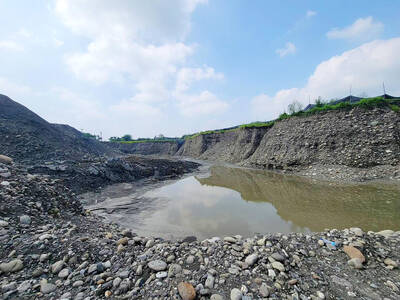
Last week the story of the giant illegal crater dug in Kaohsiung’s Meinong District (美濃) emerged into the public consciousness. The site was used for sand and gravel extraction, and then filled with construction waste. Locals referred to it sardonically as the “Meinong Grand Canyon,” according to media reports, because it was 2 hectares in length and 10 meters deep. The land involved included both state-owned and local farm land. Local media said that the site had generated NT$300 million in profits, against fines of a few million and the loss of some excavators. OFFICIAL CORRUPTION? The site had been seized
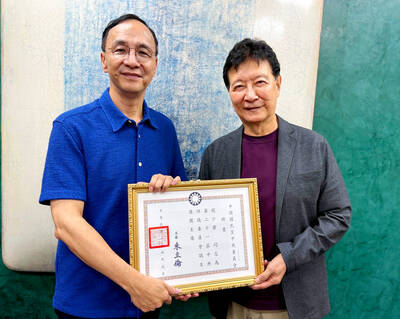
Next week, candidates will officially register to run for chair of the Chinese Nationalist Party (KMT). By the end of Friday, we will know who has registered for the Oct. 18 election. The number of declared candidates has been fluctuating daily. Some candidates registering may be disqualified, so the final list may be in flux for weeks. The list of likely candidates ranges from deep blue to deeper blue to deepest blue, bordering on red (pro-Chinese Communist Party, CCP). Unless current Chairman Eric Chu (朱立倫) can be convinced to run for re-election, the party looks likely to shift towards more hardline
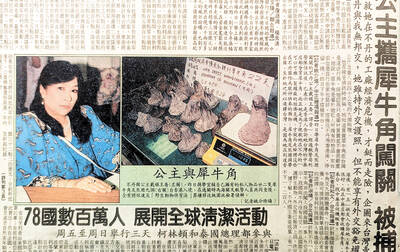
Sept. 15 to Sept. 21 A Bhutanese princess caught at Taoyuan Airport with 22 rhino horns — worth about NT$31 million today — might have been just another curious front-page story. But the Sept. 17, 1993 incident came at a sensitive moment. Taiwan, dubbed “Die-wan” by the British conservationist group Environmental Investigation Agency (EIA), was under international fire for being a major hub for rhino horn. Just 10 days earlier, US secretary of the interior Bruce Babbitt had recommended sanctions against Taiwan for its “failure to end its participation in rhinoceros horn trade.” Even though Taiwan had restricted imports since 1985 and enacted